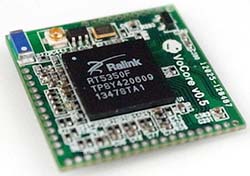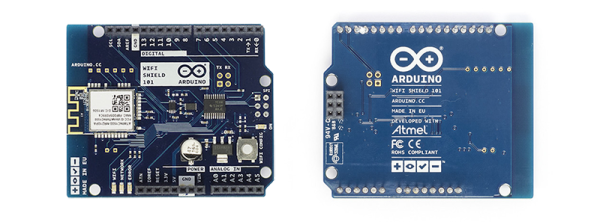For years, we have been graced with consumer electronics that run some form of Linux, have a serial port on the circuit board somewhere, and are able to be upgraded through official and unofficial means. That digital picture frame you got for Christmas in 2007 and forgot to regift in 2008? That’s a computer, and it would make a wonderful Twitter feed display. Your old Linksys WRT54G router? You can make a robotic lawnmower out of that thing. The ability to modify the firmware of consumer electronics is the cornerstone of Hackaday’s editorial prerogative. Now that right we have all enjoyed is in jeopardy, thanks to regulations from the FCC and laziness from router manufacturers.
Continue reading “FCC Locks Down Router Firmware”
802.11n3 Articles
Arduino’s Long-Awaited Improved WiFi Shield
Announced at the 2014 Maker Faire in New York, the latest Arduino WiFi shield is finally available. This shield replaces the old Arduino WiFi shield, while providing a few neat features that will come in very handy for the yet-to-be-developed Internet of Things.
While the WiFi Shield 101 was announced a year ago, the feature set was interesting. The new WiFi shield supports 802.11n, and thanks to a few of Atmel’s crypto chip offerings, this shield is the first official Arduino offering to support SSL.
The new Arduino WiFi Shield 101 features an Atmel ATWINC1500 module for 802.11 b/g/n WiFi connectivity. This module, like a dozen or so other WiFi modules, handles the heavy lifting of the WiFi protocol, including TCP and UDP protocols, leaving the rest of the Arduino free to do the actual work. While the addition of 802.11n will be increasingly appreciated as these networks become more commonplace, the speed offered by ~n isn’t really applicable; you’re not going to be pushing bits out of an Arduino at 300 Mbps.
Also included on the WiFi shield is an ATECC508A CryptoAuthentication chip. This is perhaps the most interesting improvement over the old Arduino WiFi shield, and allows for greater security for the upcoming Internet of Things. WiFi modules already in the space have their own support for SSL, including TI’s CC3200 series of modules, Particle‘s Internet of Things modules, and some support for the ESP8266.
VoCore, The Tiny Internet Of Things Thing
 With tiny Linux boards popping up like dandelions, it was only a matter of time before someone came out with a really tiny Linux board. This is it. It’s a tiny board less than an inch on each side with an 802.11n System on Chip running OpenWrt on Linux. The best part? You can pick one up for $20 USD.
With tiny Linux boards popping up like dandelions, it was only a matter of time before someone came out with a really tiny Linux board. This is it. It’s a tiny board less than an inch on each side with an 802.11n System on Chip running OpenWrt on Linux. The best part? You can pick one up for $20 USD.
The VoCore isn’t so much as a cut down ARM dev board as it is a cut down router capable of running OpenWrt. It’s not a power house by any means with 8MB of Flash, 32MB of SDRAM, and a 360MHz CPU, but if you ever need something that’s less than an inch square, you probably don’t need that much power.
The VoCore features interfaces for 100M Ethernet, USB host and device, UART, SPI, I2C, I2S, and 20 GPIOs for blinking LEDs and listening to sensors. There’s also a dock that breaks out the Ethernet and USB ports, available as a kit or already assembled.
It’s a pretty cool device, and with low current draw (about 200mA) and being able to accept +5V power, we can easily see this tiny board popping up in a few projects.













